‘Phacodrainage’ an inexpensive surgical alternative to phaco in developing world
On the first postoperative day after the phacosection procedure, central corneas were clear.
Phacoemulsification offers the advantages of rapid wound healing and early visual rehabilitation. However, economic constraints in developing countries put phacoemulsification beyond the reach of many ophthalmic surgeons.
I have developed a method of manual phacofragmentation I call “phacodrainage.” I have used this technique on more than 100 eyes since 1998.
Preoperative assessment
Preoperative assessment includes grading the nucleus, making sure that there is no zonular weakness, performing a complete ocular examination, obtaining endothelial cell counts and measuring intraocular pressure (IOP).
Three instruments are required for the surgery: an anterior chamber maintainer, an aspiration cannula and a nucleus removal tube (Triporn tube).
The idea is to crack the nucleus into small pieces and remove them through a 3.5-mm corneal incision using passive aspiration force.
The procedure
After peribulbar anesthesia is administered, I perform two paracenteses: one at 6 o’clock and one at 12 o’clock. At 6 o’clock, the anterior chamber maintainer is inserted. Viscoelastic is injected at 12 o’clock. After viscoelastic injection, I make a 3.5-mm corneal incision at a temporal site. Then I perform a large (5.5 mm to 6.5 mm) capsulorrhexis. Hydrodissection and hydrodelineation are done.
The nucleus is cracked into four pieces in the capsular bag with capsulorrhexis forceps and a Sinskey hook. The advantage of this technique is that it reduces trauma to the endothelium.
The nucleus removal tube is inserted through the corneal incision for removing the pieces of nucleus. The advantage of using this device is that wound size and wound trauma are reduced.
When the infusion line is opened, balanced salt solution is delivered to the anterior chamber via the anterior chamber maintainer. When the valve on the handle of the nuclear removal tube is open, passive aspiration force is initiated. When the valve is closed, the force is stopped. The advantage of this is that I don’t need a machine for suction, which decreases the chance of anterior chamber collapse and decreases turbulence.
Increasing the bottle height increases the passive aspiration force. A height of 60 to 70 cm is enough to create sufficient passive aspiration force.
If the pieces of nucleus are too large, Sinskey hooks are used to crack them into smaller pieces. I keep cracking until they can pass through the tube.
After removing all of the nuclear pieces, I clean the remaining cortex using an aspiration cannula.
The infusion line is turned off and viscoelastic is again injected into the anterior chamber. Finally the foldable IOL is inserted using the regular method.
Postoperative results
In patients on whom I have used this technique, on the first postoperative day, central corneas were clear, and there was trace cell and flare, which is no different from phacoemulsification.
At 3 months postop, the mean endothelial cell count was 2338.92, and mean cell loss was 16.82. Postop best-corrected visual acuity was 0.8.
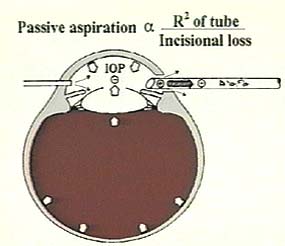 | 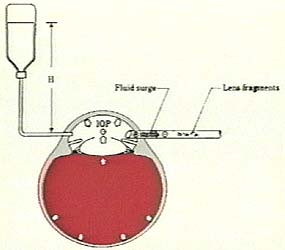 |
| Passive aspiration force is used to remove the pieces of nucleus. A bottle height of 60 cm to 70 cm is enough to create sufficient passive aspiration force. | |
Average viscoelastic substance used per case was 0.5 mL. Average irrigating fluid was 160 mL. The average time to manage the nucleus was 6.85 min.
No serious complications occurred; however, a few incidences of iris trauma and corneal wound edema occurred in our early cases.
Among the advantages of this technique are that because no ultrasound is used, there is no possibility of heat damage. It is low cost because no expensive machines are needed. Also there is less wound trauma because pieces of the nucleus are removed through the tube, not the corneal wound, and turbulence is minimized because little saline solution is used. And the small incision allows the advantages of a foldable lens.
Among its disadvantages, it can be used only in selected cases (grade 1+ to 3+ nuclear sclerosis). Operation time is greater, with an average of 30 to 40 minutes per case. There is a learning curve, and special instruments are needed.
Improvement in the nuclear removal tube will be helpful for improving efficiency. The nuclear removal tube we are using is handmade, and the reusable tube is not of good quality.
 |
 |
| A 3.5-mm corneal incision is made at a temporal site. | Hydrodissection is performed after capsulorrhexis. Note the anterior chamber maintainer. |
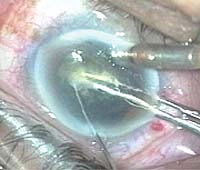 |
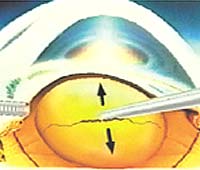 |
| The nucleus is first cracked into two pieces along the 3-to-9-o’clock axis using capsulorrhexis forceps and a Sinskey hook, in a technique similar to a pre-chop technique. | |
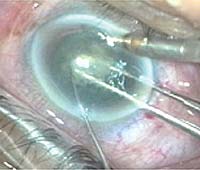 |
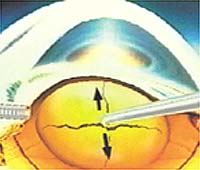 |
| Then the nucleus is further cracked into four pieces, while still in the capsular bag, using the same forceps and hook. The advantage of this technique is that it reduces trauma to the corneal endothelium. | |
 |
 |
| The nucleus removal tube is inserted through the corneal incision. The advantage of using this tool is that wound size and wound trauma can be reduced. | |
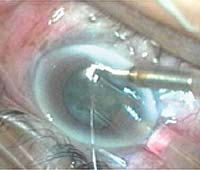 |
 |
| The nucleus is cracked into smaller pieces using the Sinskey hook. The pieces are cracked until they are small enough to be aspirated through the tube. | |
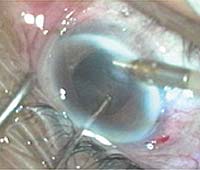 |
|
| After removing all the nuclear pieces, the remaining cortex is removed using an aspiration cannula. | |
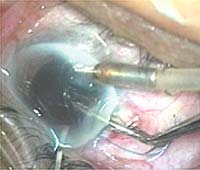 |
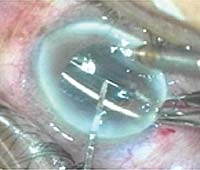 |
| Viscoelastic substance is again injected into the anterior chamber, and a foldable IOL is inserted through the 3.5-mm incision. | |
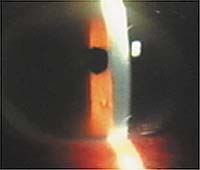 |
|
| On the first postoperative day, central corneas were clear, as in phacoemulsification. | |
For Your Information:
- Amporn Jongsareejit, MD, can be reached at Mettapracharak (Raikhing) Hospital, Sampran, Nakornpathom, Thailand, 73210; (66) 3-422541720; fax: (66) 3-4321243; e-mail: ampornj@hotmail.com. Dr. Jongsareejit has no direct financial interest in any of the products mentioned in this article, nor is he a paid consultant for any companies mentioned.
